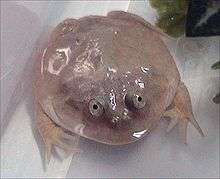Lepidobatrachus
| Lepidobatrachus | |
|---|---|
 | |
| Budgett's frog, Lepidobatrachus laevis | |
| Scientific classification | |
| Kingdom: | Animalia |
| Phylum: | Chordata |
| Class: | Amphibia |
| Order: | Anura |
| Family: | Ceratophryidae |
| Genus: | Lepidobatrachus Budgett, 1899 |
| Species | |
|
Lepidobatrachus asper (Budgett, 1899) | |
Lepidobatrachus is a genus of ceratophryidid frogs. Their common name is Paraguay horned frogs[1] or Budgett's frogs[2] (in honor of the scientist who described the genus), although the latter more commonly refers to a specific species, Lepidobatrachus laevis.[3]
Geographic range
Budgett's frogs are found in South America, in the countries of Paraguay, Argentina, Brazil, and Bolivia.[1]
Description
Lepidobatrachus frogs are generally a light, olive green in color, sometimes with lighter green or yellow mottling. They are capable of growing to an adult size of 4 to 5 inches (10 to 13 cm), with females growing slightly larger than males. They have a rounded, flattened body with eyes set high on their head, giving them a blob-like appearance. They have short limbs, which do not make them particularly efficient swimmers. They do not have teeth, but they do have two sharp protrusions inside their large mouth which serve the same purpose.
Behaviour and diet
Budgett's frogs are highly intelligent but aggressive creatures. The two sharp protrusions in their mouth allow them to attack both prey and predator alike. This frog is also known as the "Freddy Krueger" frog, because when frightened, it will open its disproportionately large mouth and emit a grunt or a shrill scream. It has even been known to bite when cornered by a human or predator. The Budgett's frog is aquatic, and spends much of its time in streams, ponds, lakes, marshes, and slow moving rivers. It is camouflaged to look like a smooth river pebble.[4]
In captivity
Due to habitat destruction, the Budgett's frog is on the verge of being listed as a threatened species , but they are becoming more common at reptile trade shows. Budgett's frogs are very rarely found in a traditional chain pet shop. The most commonly available species is L. laevis. Due to their comical appearance, they tend to make an attractive option for the intermediate to advanced amphibian keeper. They have an average lifespan of about 10 years.
References
- 1 2 Frost, Darrel R. (2014). "Lepidobatrachus Budgett, 1899". Amphibian Species of the World: an Online Reference. Version 6.0. American Museum of Natural History. Retrieved 31 December 2014.
- ↑ "Budgett's Frogs". Frog Forum. 2013. Retrieved 31 December 2014.
- ↑ Frost, Darrel R. (2014). "Lepidobatrachus laevis Budgett, 1899". Amphibian Species of the World: an Online Reference. Version 6.0. American Museum of Natural History. Retrieved 31 December 2014.
- ↑ Budgett's Frog